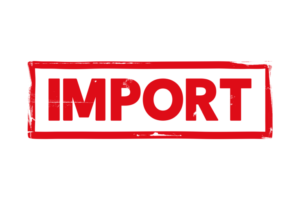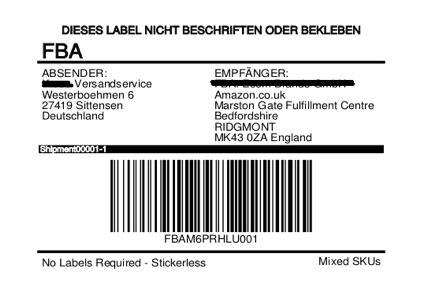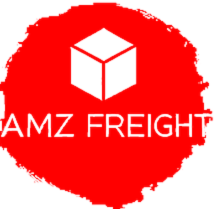Sending goods to Amazon? Import guide.
Authorities in the destination country require import customs clearance for all cargo moving into the country. The import customs clearance is the process of preparing and submitting the declaration and the required documentation to customs authorities.
The import customs clearance process can usually start before the cargo arrives at the destination, and needs to be completed before the cargo enters the country. Cargo is considered as entering the country when it crosses the border and leaves a customs bonded area.
Besides customs authorities, customs clearance procedure assumes the existence of a freight forwarder, associated agent or a nominated customs house broker, which are able to perform the import customs clearance, as long as they hold a valid license. The party performing the import customs clearance would need to receive all the required documents to initiate the process.
 In order to even start importing to the European Union, a complete application for both Valued Added Tax (VAT) and an Economic Operator Registration and Identification (EORI) number is a prerequisite.
In order to even start importing to the European Union, a complete application for both Valued Added Tax (VAT) and an Economic Operator Registration and Identification (EORI) number is a prerequisite.
The Economic Operator Registration and Identification (EORI) number is a unique identifier, assigned by a customs authority in an EU country to all economic operators (both companies and individuals) persons engaging in activities covered by EU customs legislation. Importers established outside the EU will be assigned an EORI the first time they lodge:
✘ a customs declaration.
✘ an entry summary declaration (ENS).
✘ an exit summary declaration (EXS).
Operators use this number in all communications with any EU customs authorities where an EU-based identifier is required, for example in customs declarations.
Next – VAT! When goods are imported into a country with a VAT regime, import VAT is charged as a percentage of the value of the imported goods. In addition to the VAT, customs duties will also be payable, depending on the type of goods.
The value of imported goods for the purpose of VAT is purchase priced for goods increased by:
✘ the amount of any Customs Duty, Anti-dumping Duty, Excise Duty (excluding VAT) payable in relation to their importation.
✘ any transport, handling, and insurance costs between the place of introduction into the European Union (EU) and the origin country.
✘ transport costs with EU borders up to the place of the delivery.
What is customs duty? The customs duty is determined on the basis of the commodity code and the customs value. The customs duty is usually an ad valorem duty, calculated as a percentage of the customs value of the goods. The customs duty can also be a specific duty, e.g. euros/kilo or euros/liter.
As a rule, the customs value is the purchase price of the goods + the transport and insurance costs up to the EU border.
Every imported or exported item is assigned a commodity code that corresponds to its product type. These numerical codes are used by countries worldwide for a statistic- gathering purposes, determination of import tariff rates, the determination of whether a product qualifies for a preferential (lower) tariff under a free trade agreement, a guideline for the required import documents, etc. For more information on a tariff system, please visit https://goo.gl/nWF2oh
To summarize – EU customs code which is the set of rules covering customs matters in trade with non-EU countries ensures that customs practices in all EU countries are uniform and transparent.
Labeling & Shipping Routing Guide.
When it comes to sending goods to Amazon warehouses, the most important requirements are those related to labeling and shipping & routing. I bring you an insight into all of these tiny details important for the flawless process.
Labeling
FBA uses barcodes to identify and track inventory throughout the fulfillment process. Each product sent to an Amazon fulfillment center requires a barcode. There are two kinds of barcodes that are used to identify products:
✘ Manufacturer barcodes (eligible barcodes include GCID, UPC, EAN, JAN, or ISBN).
✘ Amazon barcodes (ASIN, FNSKU, or MSKU).
Products that do not use the manufacturer barcode for tracking, require an Amazon barcode. A seller can print Amazon barcodes from within the seller account and apply the barcodes. If a seller does not want to apply the barcodes, they can sign up for the FBA Label Service and have Amazon apply the labels for a per-item fee ($0.2).

Each box or pallet shipped to an Amazon fulfillment center must be properly identified with a shipping label. Guidelines for labeling boxes:
✘ Labels supported measure 63,5 x 29,6 mm.
✘ Don’t place labels on a seam on the box where they will get cut by a box cutter.
✘ The FBA shipment label should be placed next to the carrier (UPS, Fed Ex or other) label.
✘ Both the FBA shipment label and the carrier label (UPS, Fed Ex, or other) must remain uncovered so they are scannable and readable.
✘ Each box you include in the shipment must have its own label. Each pallet needs four labels, one in the top center of each side.

Besides product barcode and shipping label, there is a question of a shipping mark. A shipping mark is simply a mark on the outside of the exterior shipping carton of an item being exported. At the minimum, shipping mark should include weight and dimension of a single carton, the number of the carton and total number of cartons (such as 1/50, 2/50, 3/50), the number of units in carton and information on actual product (content), country of origin (“Made in China”), manufacturer’s information.
Shipping & Routing
There are standard requirements that apply to all boxes shipped to Amazon fulfillment centers whether by small parcel delivery, less than truckload (LTL), or full truckload (FTL). These requirements are related to box content information, box dimension (“Boxes containing multiple standard-size items must not exceed 63 cm on any side”), box weight (“Boxes must not exceed the standard weight limit of 30 kg, boxes weighing between 15 kg and 30 kg must be marked “Heavy Package”), approved containers and even approved forms of dunnage! For more detailed information on these matters, please visit https://goo.gl/1ZYcMJ.

Based on the shipping method used, there are additional requirements:
✘ Small Parcel Delivery Requirements.
✘ Arranging for Less than Truckload (LTL) or Full Truckload Deliveries to Amazon.
I’ve already shared some brief guidelines for small parcel delivery requirements in the initial paragraph. As for LTL or Full Truckload shipments, including wrapped pallets, these require additional preparations. Seller and chosen carrier are responsible for meeting these when sending large-volume shipments to Amazon. Some of these requirements are related to:
✘ Using acceptable pallets (in all EU countries – 800×1200 mm Euro/CHEP certified DIN 15146)
✘ Building pallet shipments (pallets can be built up to a maximum of 1.8 meters high, including the pallet. Double stacked pallets: 2.7 meters for DE /CEE and 3.0 meters for UK, FR, IT and ES. For details, see EU FCs addresses and delivery specifics)
✘ Adhering to pallet label requirements.
✘ Providing the bill of lading (BOL).
✘ Scheduling a delivery.
✘ Providing your carrier with Amazon reference IDs, shipment IDs, and tracking (PRO) numbers.
There are even carrier-related requirements. So, what the carrier needs to do?
✘ Has Amazon Reference IDs, Shipment IDs, and tracking (PRO) numbers.
✘ Schedules advanced delivery appointments.
✘ Adheres to the vehicle condition requirements.
Having some more questions? Get in touch with me at office@amzfreight.com

